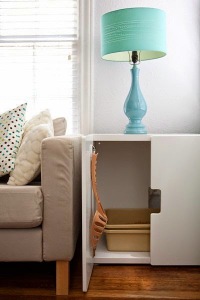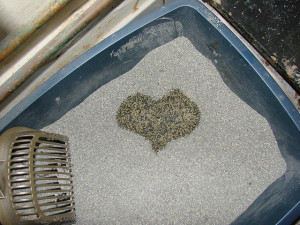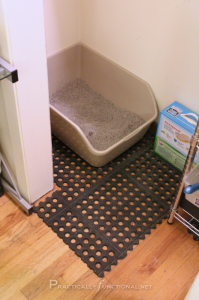
Once cleared by a vet, it’s time to start thinking about what your cat is trying to tell you. This requires a bit of investigation, or as Pam Johnson-Bennett says, “think like a cat!” Here’s some common things to consider:
Location, location, location!
While some cats are solitary beings, and prefer to do their business in peace, others enjoy the prospect of a social ritual around the litter box. Where is their box located? Is it in a high-traffic area, where they me startled or find the lack of peace distracting? Is it downstairs, far away from any communal area where they may hang out? It’s a good idea to try different places for the litter box, even using multiple boxes as you determine where your cat likes to do his business. In a multi-level house, you may want to consider a box on each floor, or at least keeping it on the middle floor. How would you like it if you woke up in the middle of the night on the third floor, and the toilet was all the way downstairs? And never place the litter box near your cat’s food and water. We don’t eat in the bathroom, why should they?
Doing your business in style!
Sometimes your cat just isn’t happy with his box. We like to be comfy while we.. er, do our thing, and so does he! Is the box too small? Too large? Perhaps it’s hooded and he would prefer the open air between his cheeks! A liner or lid may make it uncomfortable. The rim might be too high for him to climb into, or the self-cleaning mechanism might freak him right out. Perhaps a different box will make all the difference. And keep it clean! Litter boxes should be cleaned daily, not only to prevent discomfort or smell, but also to reduce risk of certain diseases like coronavirus spreading. If you live in a small space, such as an apartment, you can “catify” your open litter box by making an entrance in a large Rubbermaid container, or in a storage ottoman! This allows the cat to have his box without a low ceiling, but doesn’t leave your guests eyeing up the litter all day. You could even have two entrances for even more freedom.
 Multiple cats, multiple boxes!
Multiple cats, multiple boxes!
Every cat should have his own litter box. Urine is a “marker” for many animals in the wild, and your cat may prefer to use his own box, with his own smell. The multiple boxes can be placed in the same location next to each other, but sometimes having that option of ownership makes his territorial issues a little more bearable. You may also notice that cats have a tendency to urinate in one box, and defecate in the second. It’s a weird thing science can’t explain, but sometimes even with a single cat a second box is an easy fix.
Sand between my toes!
Cats can be picky – you may have noticed this with food and treats, but litter can also be a choice! Clay based litters are hard, and can hurt delicate paws and declawed cats. Some of the other options you have are: plant-based (such as World’s Best Cat Litter and Swheat Scoop), newspaper based (such as Yesterday’s News), or weird plastic things called Litter Pearls. Some cats are turned off by clumping litter, while others are grossed out by non-clumping. Scents can also cause aversion to litter boxes. If you want to deodorize, use a deodorizing litter or plain old baking soda. Finally, if your cat came from the outdoors, they may be confused by litter and need a little encouragement, such as sprinkling grass clippings on top of the litter in the beginning. And remember, one to two inches is all they need. If your cat feels like he’s sinking in quicksand, he’s not going to want to stay in there long!
In this corner, your cat!
Cats are territorial. We all know it, we all neuter and spay to prevent it! In multi-animal households, cats need to feel like they have a “safe” place. Whether it’s from another cat, a dog, or a child, your cat is like a teenager – he needs his own room! Sometimes cats will pee on new things to show their displeasure, or to mark it as their own. This could be a new couch, the new guy’s cat bed, or a new baby’s crib. This sort of behaviour is harder to correct. Does your cat have his own “safe” place? His own bed, or his own cat tree? You can try placing his things on the new items, for example, placing his blanket on the new couch, or his cat bed in the baby’s room. Purchasing new items just for him may also make a difference, rub his scent all over that new cat tree and show him it’s all his. If reasonable, make it easy for him to get away from the new guys – whether it is up on top of the fridge, or installing some IKEA shelves for him to climb up and away from grabby hands. Talk to your vet about other ways to correct marking.
Here’s some tips for dealing with the aftermath:

As with the litter box, cats like to urinate in the same place, for comfort, territory, and habit. If the ammonia isn’t completely wiped from the material, your cat will return there thinking, “hey! I peed here once!” and do it all over again. You can try putting a litter box where he has urinated before, giving him the option of continuing to use his favorite area. On the other hand, you can make his favorite spots less appealing by putting motion activated deterrents like lights or air-puffers. You can also create deterrents on the floor, such as turning a piece of carpet upside down or taping down a sticky substance like fly paper or double sided tape.
Note: Never punish your cat for urinating. He is trying to tell you something is wrong, whether he is upset or ill, it is important to correct the behaviour instead of instilling fear. Causing your cat to be afraid of urinating will only cause more problems for you both! Never lock him in a room or kennel, never rub his nose in his urine or feces, and never scold him or hit him for urinating. Do NOT spray your cat with a water bottle. Cats don’t respond to discipline the same way dogs or humans do. Keep doors closed if he is urinating in recurring rooms (like your bedroom), and always remember that your vet knows more than your friend, Google, or me!






